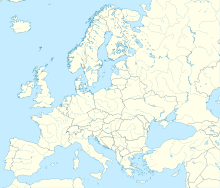Riga-Kaiserwald concentration camp
Riga Imperial Forest concentration camp in Latvia
|

The Kaiserwald concentration camp was a National Socialist concentration camp in Latvia , in the north of Riga , in the Mežaparks district (German: Kaiserwald).
history
The camp was headed by Eduard Roschmann , the "butcher of Riga", who previously ran the Riga ghetto . After the fall of the National Socialist German Reich , he fled with the help of the Italian Caritas and a forged Argentine passport via Genoa and one of the so-called rat lines to Argentina, where he built a new existence as Federico Wegener.
The camp was established in March 1943 to imprison Jewish residents of the occupied Baltic territories. In particular, from June 1943, the survivors of the Riga ghetto and the ghettos in Liepāja , Daugavpils and Vilnius were interned here.
Several hundred convicts from Germany were among the first inmates of the concentration camp. After the occupation of Hungary by the Germans, Hungarian Jews were brought to Kaiserwald, as were a number of Jews from the ghetto in Łódź . In May 1944 there were 11,878 prisoners in the main camp and its satellite camps, of which 6,182 were men, 5,696 women and only 95 were non-Jews.
In contrast to Auschwitz or Treblinka , Kaiserwald was not an extermination camp . Large German companies, mainly AEG , used numerous inmates from Kaiserwald as forced laborers for the production of their electrical devices. For this purpose, the branch offices in Riga on Balastdamm (August 18, 1943 to August 7, 1944), in the Dünawerken (August 18, 1943 to July 1, 1944), in the army vehicle park (August 18, 1943 to August 6, 1944) and his Branch office set up in Hirtenstrasse (January 31, 1944 to August 6, 1944). Further branches established from August 18, 1943 were in Riga Lenta, Riga Mühlgraben, Riga Strasdenhof on Widzemer Chaussee and at the Riga Reichsbahn. In Riga Spilwe a branch was operated from July 5, 1943, in Riga Strasdenhof on Widzemer Chaussee by AEG from August 1, 1943, and from June 1, 1944 also in the local anode workshop.
Because of the advance of the Red Army on the Baltic countries, the Germans began to "evacuate" the camp and in September 1944 to bring the prisoners to the Stutthof concentration camp in the Gau Danzig-West Prussia. From the point of view of the Nazi perpetrators, the term “evacuate” can mean two processes: evacuation or mass murder of the prisoners before Allied troops reach the camp area. Those believed to be unable to make the trip were shot dead. In particular, all Jews who had committed “criminal offenses”, even if they were only minor offenses, but also all Jews who were younger than 18 or older than 30, were murdered immediately before the camp was evacuated. At the end of September the camp was "cleared" of prisoners.
The Red Army liberated the concentration camp on October 13, 1944.
See also
- Riga ghetto
- List of satellite camps of the Riga-Kaiserwald concentration camp
- Jungfernhof subcamp, extermination site
- Salaspils Police Prison and Labor Education Camp
- The Odessa files
literature
- Andrej Angrick , Peter Klein: The “Final Solution” in Riga. Exploitation and extermination 1941–1944. (Overall presentation). Scientific Book Society (Series: Research), Darmstadt 2006.
- Franziska Jahn: Riga-Kaiserwald - main camp . In: Wolfgang Benz , Barbara Distel (eds.): The place of terror . History of the National Socialist Concentration Camps. Volume 8: Riga, Warsaw, Vaivara, Kaunas, Płaszów, Kulmhof / Chełmno, Bełżec, Sobibór, Treblinka. CH Beck, Munich 2008, ISBN 978-3-406-57237-1 .
- Bernhard Press: Murder of Jews in Latvia 1941–1945 . 2nd, change Edition. Metropol, Berlin 1995, ISBN 3-926893-13-3 .
Web links
- History of the Jews in Latvia (in English)
- Kaiserwald near Riga (report, English)
Coordinates: 56 ° 59 ′ 49.2 ″ N , 24 ° 7 ′ 52.5 ″ E


